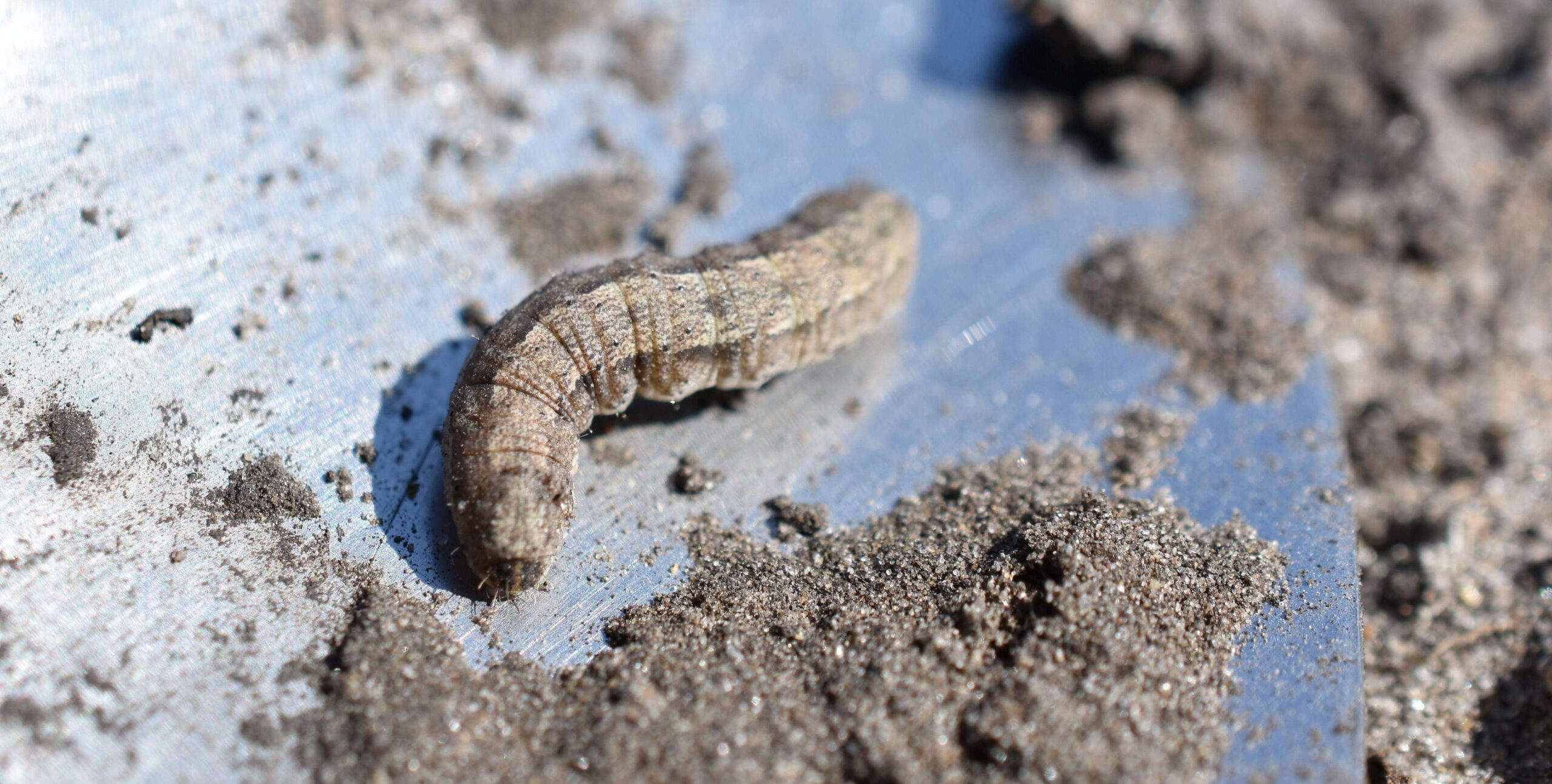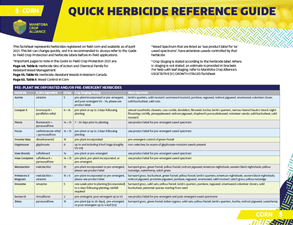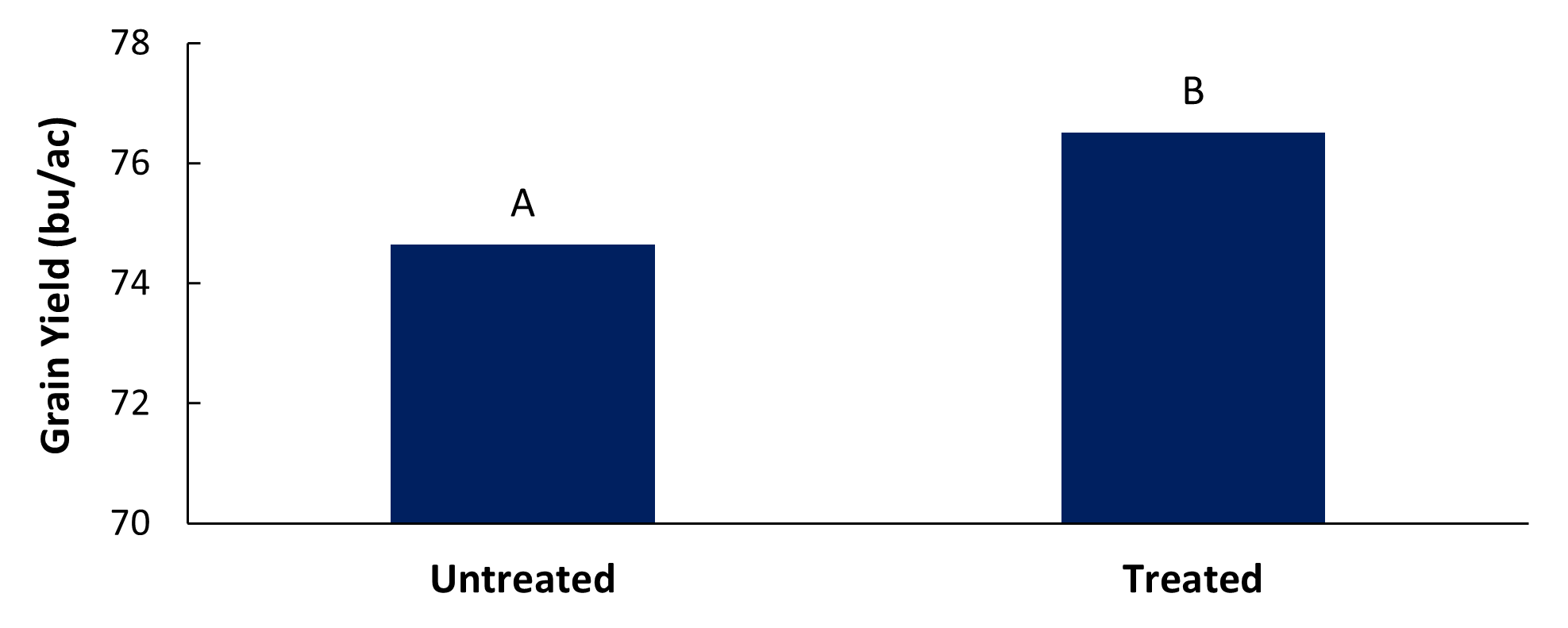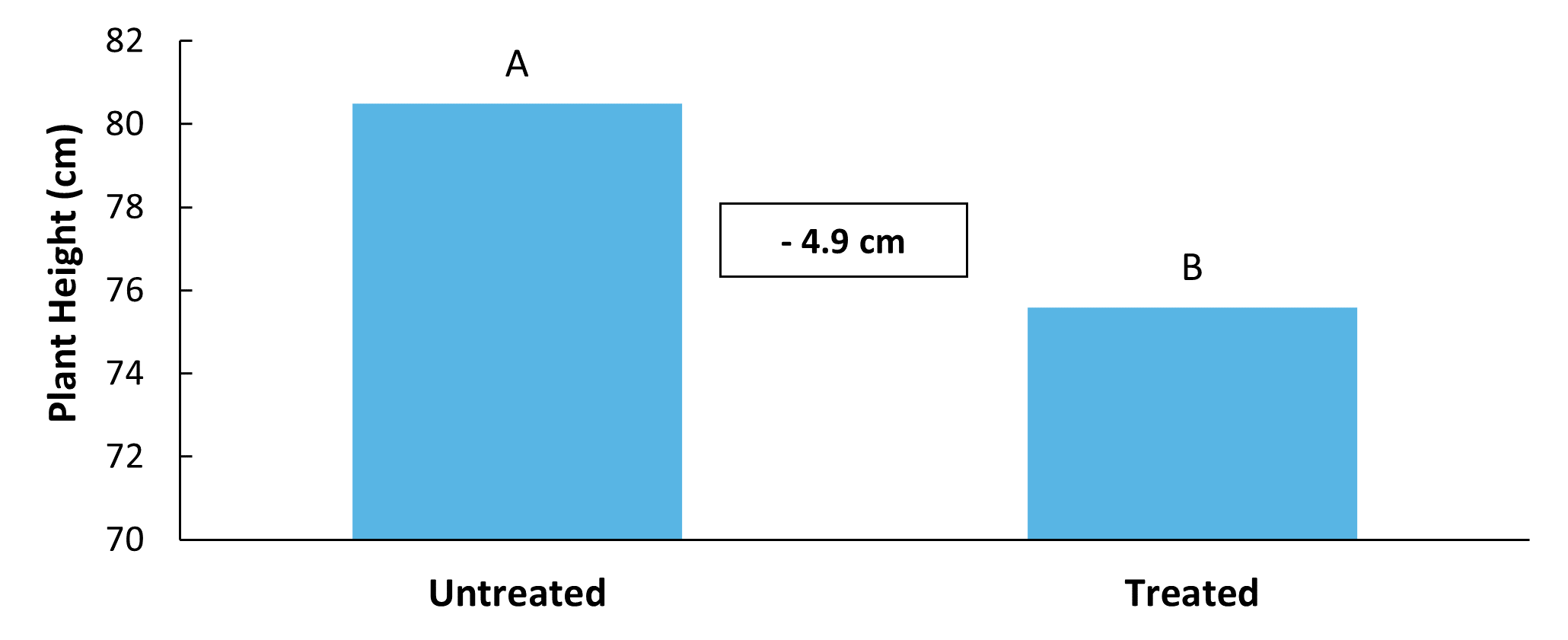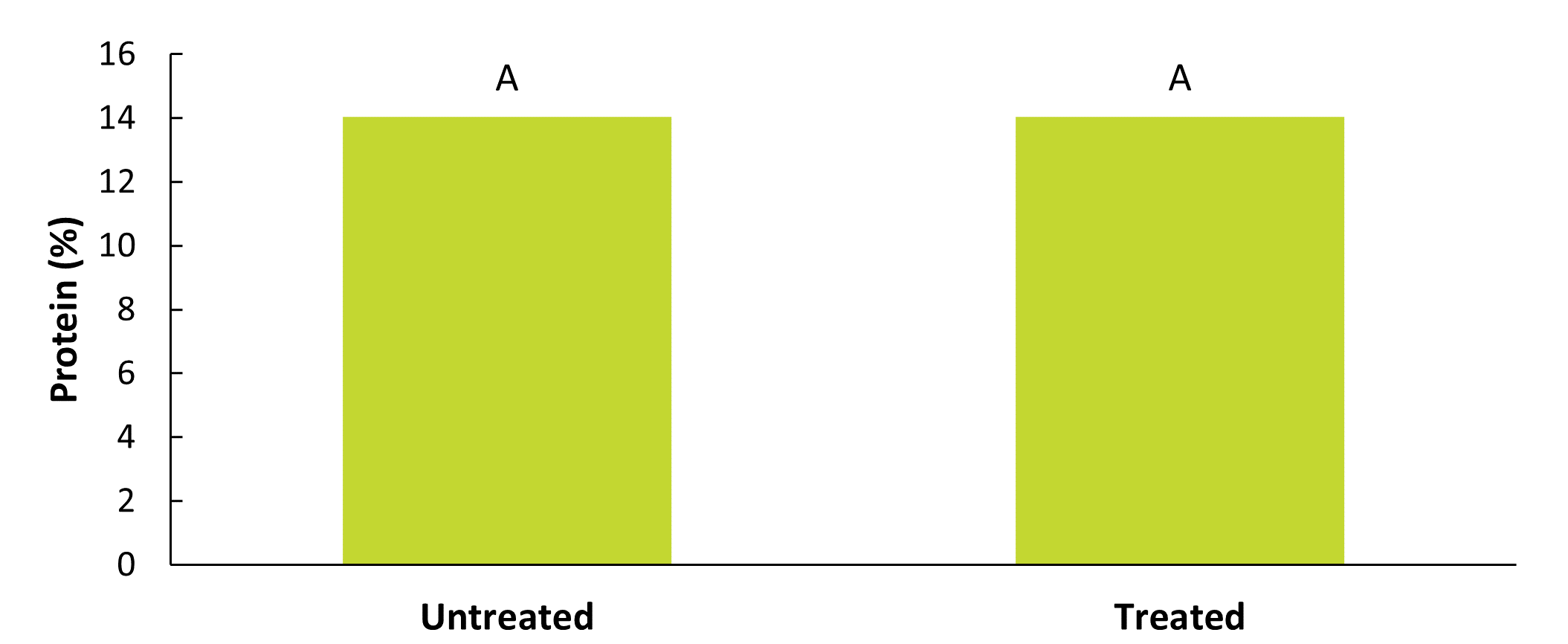Flax: Emergence and Frost
Frost Impact on Flax
Flax plants just emerging (cotyledon stage) are the most susceptible to early spring frost, but can withstand temperatures down to approximately -3° Celsius. After the seedlings have passed the two leaf stage and are hardened by exposure, they can withstand temperatures as low as -8°C for a short time, without significant damage (https://flaxcouncil.ca/growing…).
Flax is generally at the first whorl stage right now, so a hard frost can have significant damage on the crop. It is important to follow the typical frost scouting techniques and wait 3-5 days to see whether frost has impacted the crop or not.
Emergence Monitoring (posted by SaskFlax: https://www.saskflax.com/quadr…)
One way to work towards optimizing flax performance on your farm is to determine the plant population and calculate emergence rate. Relating these numbers back to the seeding rate used, the environmental conditions and other factors at seeding can help determine management practices for the growing season and adjustments that can be made next year.
Steps to determine actual plant population and emergence rate:
1. At 1.5 to 2 weeks after seeding, count the number of plants per square metre or foot in a few representative locations in the field and calculate the average. This number is the plant population. To maximize yield potential, the minimum desired population for flax is 300 plants/m2 (28 plants/ft2) and the maximum is 400 plants/m2 (37 plants/ft2).
READ MORE at SaskFlax’s May 2021 edition of Flax on the Farm
Sunflower Frost Tolerance
Frost Tolerance
Sunflowers are fairly frost tolerant up to the V4 or 4 leaf stage. The cotyledons just emerging are most frost tolerant, with risk of injury increasing as the plant adds leaves. If sunflowers become brown or black and the terminal bud is severely damaged, plants will not recover. Less severe frost damage may result in loss of apical dominance and plants will exhibit branching from axillary buds, resulting in multiple heads later in the season.
Tolerance to frost in sunflowers can be influenced by the hardening off process. If it is cool or cold for several days previous to the frost, seedlings may have better tolerance to lower temperatures. (https://www.gov.mb.ca/agricult…)
Plant Population
As the crop appears to be fully emerged in the late VE staging, it is a great time to do population counts to determine planting accuracy. Not all sunflower plants may have emerged at this stage, which makes timing appropriate. If the majority of the crop has emerged, a producer should be assessing what percent of the crop remains below the soil surface and why they are behind the rest of the crop. Dry soil, poor seed to soil contact, and consistent planting depth were all planting issues that have to be contended with in extremely dry planting conditions. Go out to the field and do some plant counts now to determine what may have gone wrong just a few weeks ago. Assessing a planting situation at harvest is not the time to learn from mistakes or environmental challenges.
To estimate plant population of emerged crop, determine the length of 1/1,000th acre using the table below (http://corn.agronomy.wisc.edu/AA/A033.aspx). Measure that distance out and count how many plants have emerged. Record the number. Repeat this 10 times at random locations to get an estimated average of final plant population.
This is also the ideal time to be scouting for cutworms. John Gavloski, provincial entomologist with MARD, suggests scouting to make sure some cutworms are present before applying an insecticide. This time of year there can be a lot of natural enemies emerging. One John sometimes finds in high numbers early in the season is a small ground beetle called Bembidion, that can be very good at keeping levels of some other insects down. John warns that it would uneconomical to take out populations like these if the cutworm population was low. The take home message with early cutworm control is to always scout before applying an insecticide and avoid the proactive insecticide application.
Corn Emergence – Early Concerns
SPRING FROST:
Late May consistently brings early frost concerns in all crops. Corn is quite tolerant of temperatures below freezing because the growing point remains below ground until V6 approaches, however, if air temperatures dip below -2oC for more than a few hours, it is possible for the growing point to be damaged. See Is Corn Susceptible to Spring Frosts for temperature and scouting details following a spring frost event.
COLD BANDING:
Due to typical warming, followed by cooling spring temperatures as the corn crop was emerging, at VE and V1 staging it is possible to see cold banding on seedlings. As elongation occurs below the soil surface during warm conditions, a period of chilling can create a few growth issues. Most common is imbibitional chilling injury, which is the twisting or corkscrewing of corn mesocotyl as it is trying to emerge. This is when seed has imbibed (absorbed) the water required for germination and then the soil cools to temperatures below 10oC for prolonged periods. Cold banding is when air temperatures drop to 5 – 10oC and plants close to the soil surface get a yellow band across the leaf tissue. This is not cause for concern, but a common site at this time of year when temperatures bounce around.
PLANT POPULATION:
As the crop appears to be fully emerged in the late VE staging, it is a great time to do population counts to determine planting accuracy. Not all corn plants may have emerged at this stage, which makes timing appropriate. If the majority of the crop has emerged, a producer should be assessing what percent of the crop remains below the soil surface and why they are behind the rest of the crop. Dry soil, poor seed to soil contact, and consistent planting depth were all planting issues that have to be contended with in extremely dry planting conditions. Go out to the field and do some plant counts now to determine what may have gone wrong just a few weeks ago. Assessing a planting situation at harvest is not the time to learn from mistakes or environmental challenges.
To estimate plant population of emerged crop, determine the length of 1/1,000th acre using the table below (http://corn.agronomy.wisc.edu/AA/A033.aspx). Measure that distance out and count how many plants have emerged. Record the number. Repeat this 10 times at random locations to get an estimated average of final plant population.
WEED CONTROL:
The first in-crop herbicide applications can occur at VE in glyphosate-tolerant corn. Due to the dry conditions prior to May long weekend, weed emergence was slow. Following varying rainfalls, weeds will likely be germinating quickly now, so it will be important to stay ahead of weed pressure. See MCA’s Quick Herbicide Reference Guide to see what can be applied and when for certain weed spectrums. It is always recommended to refer to the herbicide label for complete information or Manitoba’s Guide to Field Crop Protection prior to all applications.
Manitoba Crop Alliance and University of Manitoba advancing Canadian agriculture through new research facility
FOR IMMEDIATE RELEASE
Tuesday, May 11, 2021 (Carman, MB) – Manitoba Crop Alliance (MCA) is contributing $500,000 to the University of Manitoba (UM) towards the building of the Prairie Crops & Soil Research Facility (PCSRF). The PCSRF will further strengthen the UM’s already well-recognized agronomy and crop production teaching and research programs. Construction of the new facility will begin next year.
“I thank our research collaborators at MCA for their leadership and vision in the support of the new PCSRF, one of the Faculty’s most significant renewal strategies for research in crop production. This gift represents investment in agricultural research by Manitoba’s farmers that will foster the development of integrated and resilient agronomic systems to the benefit of Western Canadian producers,” says Dr. Martin Scanlon, Dean, Faculty of Agricultural and Food Sciences, UM.
The PCSRF will increase the capacity for crop research and allow scientists to better integrate soils, crop, entomology and livestock research to make crop production in Manitoba more sustainable. Farmers in Manitoba will benefit from research topics including agronomic and cropping systems for optimized performance and longer-term sustainability, weed management, advanced crop protection, new cultivars and crops, profitability of nutrient strategies, and carbon benefits of crop production practices.
“MCA wishes to express our gratitude for the UM’s continued commitment to the improvement of facilities and equipment that are so essential for advanced modern research and the training of highly qualified personnel,” says Fred Greig, Chair of MCA. “We anticipate this expansion and modernization of research capacity at the UM will accelerate the growth and health of our industry by putting innovative solutions in the hands of our farmer members.”
MCA values the partnership with the UM and are currently supporting 30 projects totaling approximately $500,000 per annum. MCA will continue to work together with the UM to address research priorities and communicate research results to our members.
For more information about MCA research investments, please visit mbcropalliance.ca/research/projects. For more information about the UM, please visit https://umanitoba.ca/agricultural-food-sciences/.
-30-
About Manitoba Crop Alliance:
Manitoba Crop Alliance is a non-profit organization established August 1, 2020 representing over 9,000 farmer-members. Manitoba Crop Alliance puts their farmer-members first and strives to continuously improve the competitiveness and profitability of all crops represented by the organization by focusing on four main areas: research, agronomy, market access and development, and communications. It is through investment in these key areas that Manitoba Crop Alliance can ensure wheat, barley, corn, sunflower and flax are sustainable production choices for Manitoba farmers. For more information, visit mbcropalliance.ca.
About University of Manitoba:
The University of Manitoba is home to a community of more than 29,000 students, 5,000 academic staff and 3,900 support staff. Recognized as Western Canada’s first university and located in the city of Winnipeg, the University is committed to advancing Indigenous research and achievement, recognizing the significant contributions of Indigenous peoples in Canada. UM is one of the U15, ranking among Canada’s top research-intensive universities and is Manitoba’s only medical-doctoral post-secondary institution. Providing high-quality liberal arts, science and professional programs of study, the University inspires undergraduate and graduate students to positively impact their communities as globally-engaged citizens.
For more information, please contact:
Pam de Rocquigny
Chief Executive Officer
Manitoba Crop Alliance
204.745.6661 | pam@mbcropalliance.ca
Brooke Karlaftis
Donor Relations
University of Manitoba
204-474-7835 | Brooke.Karlaftis@umanitoba.ca
Research on the Farm – Looking at the Effect of Plant Growth Regulators on Spring Wheat
Lodging is a major production issue in cereal crops. Cereals are especially prone to lodging in high-yielding environments. The greatest losses tend to occur 10 days to two weeks after head emergence. Plant growth regulators (PGRs) are a management tool available to reduce lodging in certain circumstances. PGRs are synthetic compounds that alter hormonal activity in the plant to modify plant growth and development, and are typically used to improve standability as they produce shorter, thicker stems. When are they warranted?
According to Anne Kirk, Cereal Specialist with Manitoba Agriculture and Resource Development, a PGR is most likely to be beneficial when you are growing a variety that is prone to lodging, using intensive management practices, and have high yield potential. “If a farmer is using a variety that might be prone to lodging and using a high nitrogen rate that will increase the plant growth, there is an increased risk of lodging and a farmer may want to consider using a PGR,” says Kirk.
Certain varieties respond more to PGR applications than others as PGR response is very variety specific. Conditions have to be really good for plant growth to consider using a PGR. Have growing conditions been really favourable? Does the wheat or other crop have really good yield potential? Environmental conditions leading up to PGR timing and the crops growth and yield potential could warrant it, especially if it’s a variety prone to lodging. On the other hand, if a plant is under any stress such as waterlogging, drought, nutrient deficiency, frost, insect or disease damage, a PGR should not be used. Since the plant is already under stress, applying a PGR could cause unintended consequences.
There are two main types of PGRs registered for use on spring and winter wheat, oats and barley in Western Canada – Manipulator and Moddus. The active ingredient in Manipulator is chlormequat chloride and the active ingredient in Moddus is Trinexapac-ethyl. Although the two have different active ingredients, their application timing and the crops they are registered for use on are quite similar.
“I think farmers would like to apply a PGR as a tank mix (with herbicides or fungicides), but the ideal timing for application is between herbicide timing and fungicide timing,” adds Kirk. “Herbicide timing is too early because the nodes haven’t emerged above the soil surface, and fungicide timing is too late (if targeting flag leaf timing for fungicide) because those nodes have already elongated. Applying a PGR isn’t going to shorten the plant at that point, it would just prevent future growth.”
Through the Research on the Farm program, Manitoba Crop Alliance (MCA) has been testing the efficacy of Manipulator since 2016, and is adding Moddus to the program in 2021. The objective of the Research on the Farm trial is to quantify the agronomic and economic impacts of using a PGR on plant height, lodging, yield and quality of wheat.
The PGR trial has run for three growing seasons (2018-2020) at a total of 32 sites. Three indicators were measured to get an idea of how the PGR application performed compared to the untreated check strips, grain yield (bu/ac), plant height (cm) and grain protein (percent). A small but significant effect was observed on grain yield, where a PGR application resulted in an average increase of 1.9 bu/ac. Similarly, plant height was also significantly impacted, where treated strips were on average 4.9 cm shorter than untreated check strips. Average grain protein across all site-years was 14.0%, for both treated and untreated strips, and no significant differences were observed. All three growing seasons (2018-2020) were relatively dry. Ideally, MCA would like to see data from a year with more moisture.
Figure 1. Average grain yield across all site-years (2018-2020) was 74.6 bu/ac for untreated strips and 76.5 bu/ac for strips treated with a PGR, resulting in a statistically significant yield increase of 1.9 bu/ac (P<0.05).
Figure 2. Average plant height across all site-years was 80.5 cm for untreated strips and 75.6 cm for strips treated with a PGR, resulting in a significant height reduction of 4.9 cm (P<0.05).
Figure 3. Average protein content was 14.0% for both untreated and treated strips across all site-years. No significant effect on grain protein content was observed in these trials.
Amy Mangin, a Ph.D. student at the University of Manitoba, is looking at PGR use in spring wheat as part of her research project. The project investigates PGRs and their interactions with different spring wheat varieties, nitrogen management strategies and planting densities. It also compares yield, protein and nitrogen use efficiency of spring wheat with and without PGRs.
“We’re looking at lodging as a whole aspect. Measuring things like stem strength, rooting plate, internode lengths and stem diameter,” says Mangin. “We’re using more detailed measurements to quantify how the PGRs are affecting the risk of lodging.”
PGRs reduce lodging typically through decreasing the canopy height as well as increasing stem strength. “We had a higher decrease in lodging when higher rates of nitrogen were applied as well as when high seeding rates were used,” says Mangin. “We really saw the benefit of the PGR when we were pushing yields with high N rates and high seeding rates.”
The objective of the three-year project is to better understand how high yielding spring wheat varieties respond to management practices such as nitrogen management, PGR application and seeding rate as well as their interactions and how these may influence lodging risk, yield and protein in Manitoba growing conditions.
For more information, please visit Agronomic Practices to Minimize Lodging Risk while Maintaining Yield Potential in Spring Wheat





